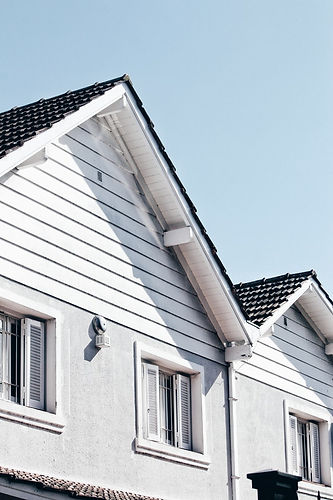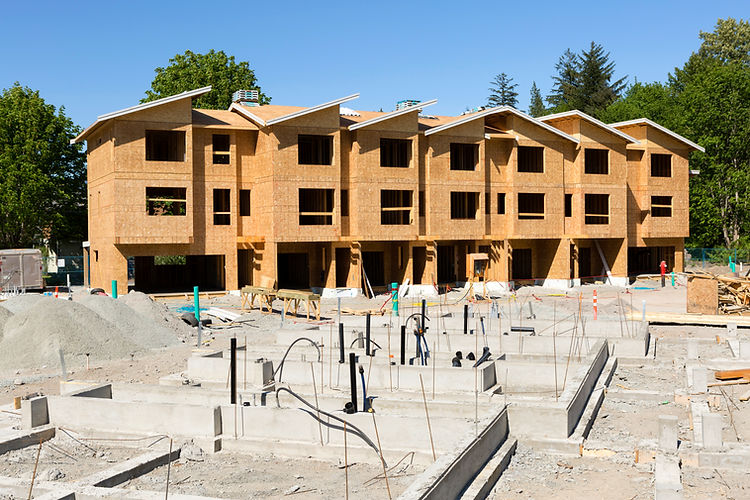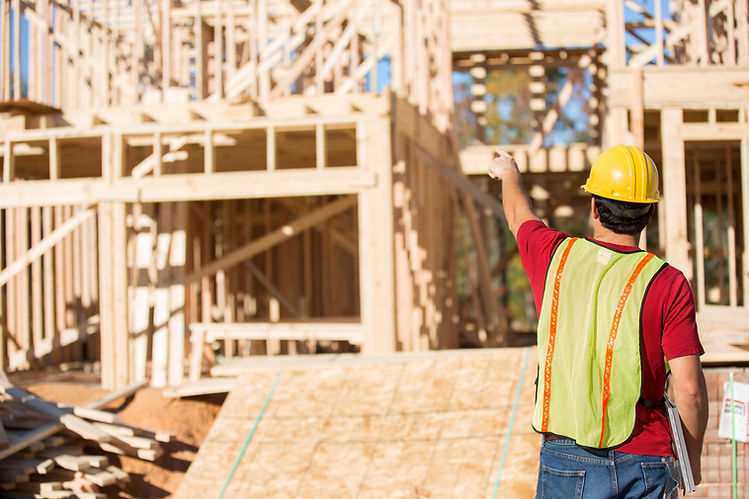
BUILDERS RISK INSURANCE
PROTECTING ALL CONSTRUCTION PROJECTS FROM SMALL HOME OWNERS TO
LARGE GENERAL CONTRACTING FIRMS

WHAT IS BUILDERS RISK INSURANCE?
Builders Risk Insurance provides coverage for ground up construction, residential and commercial structures while they are being remodeled or renovated.
Builder’s Risk Insurance, also known in some areas as Course of Construction, is a unique kind of property insurance. It's a form of insurance that covers a building where the building or insured area is presently being constructed. It can cover just the structure, or also the materials on-site waiting to be installed or transported to the job site and is a type of insurance that most owners will ask every contractor to carry.
The builder's risk insurance policy will pay for damages up to the coverage limit. The limit must accurately reflect the total completed value of the structure (all materials and labor costs, excluding land value). The construction budget is the best source for determining the appropriate limit of insurance. Builder’s Risk insurance policies can often be written in terms of three months, six months, or 12 months. If the project is not completed by the end of the initial policy term, it can often be extended, but usually only one time.

UNDERSTANDING BUILDERS RISK COVERAGE
The builder's risk policy will provide coverage for damage done to the insured structure from a wide variety of events. Damage from the following events will be covered by most policies:
-
Fire
-
Wind (may be limited in coastal areas)
-
Theft
-
Lightning
-
Hail
-
Explosion
-
Vandalism
-
Vehicles or aircraft
You should read your builder's risk insurance policy to be familiar with its limitations and exclusions. Limited coverage is provided for collapse among other situations. Standard exclusions include:
-
Earthquake
-
Employee theft
-
Water damage
-
Weather damage to property in the open
-
War
-
Government action
-
Contract penalty
-
Voluntary parting
-
Mechanical breakdown
An important exclusion that should be read in its entirety excludes coverage for damage resulting from faulty design, planning, workmanship, or materials. These types of issues might be addressed by professional liability coverage rather than a builder's risk plan. Earthquake and flood coverage may be purchased in some areas.
If a disaster befalls your structure – be it a weather phenomenon, natural disaster, or vandalism – builders risk insurance generally covers demolition expenses so you can clear away debris and begin rebuilding.
It’s painful enough watching your hard work destroyed and having to start from square one, without the added discomfort of breaking your own bank to get there. With course of construction coverage, you’re able to focus on getting your project back on track as soon as possible and without the worry of juggling the expenses.
If you are a homeowner or General Contractor with an active jobsite you should consider purchasing Builders Risk Insurance. No matter how much you plan for a project to run perfectly, there is always the chance that an unforeseen event may lead to damages. Whether it be theft of materials/tools at the site, weather-related damages, or damages to the structure itself, Builder’s Risk coverage will make you whole in the event of a loss.

CAN I PURCHASE BUILDERS RISK INSURANCE AS A HOMEOWNER
Absolutely you can. A homeowner may act as an owner builder when building or rehabbing a home they use as their primary residence. However, it is wise to hire a credible General Contractor if you lack experience in the various aspects of construction.
WHAT BUILDERS RISK DOESN'T COVER
A builders risk policy is generally written as an “all-risk” policy, which means it covers just about every risk you can think of. But it doesn’t cover absolutely everything. Here are a few things this broad policy typically doesn’t include coverage for:
Small repairs
Builders risk insurance is intended for major construction or remodels to residential and commercial structures, not smaller repairs.
Specifically excluded incidents
Incidents outlined as excluded from your policy will be outside your business’ insurance coverage.
Intentional acts or fraud
If damage or loss occurs due to dishonesty or through intentional behavior than a builders risk policy will not cover it. Builders risk is not required by law but it may be necessary to assure your peace of mind.
Know that your tools, equipment, and materials are protected when you’re up against a tight deadline and that you won’t be stuck covering the high costs should disaster strike.

HOW MUCH DOES A POLICY COST?
This policy will be in the range of one to four percent of the construction cost, but it will depend on the type of coverage and exclusions that the policy will have. The importance of having a solid insurance company is that they will expedite your claims and will help you solve any potential claims during the construction process. Some companies can cover the soft costs of the project, but you will need to ask the insurance company to include it in your coverage but be aware that this might increase the cost of your builder's risk. The builder's risk insurance is part of your project's soft costs, and even though it will cost you some money, it is better to have it than not having it when is needed.
WHO PAYS FOR A BUILDERS RISK POLICY
Since there is only one builders risk policy covering a project, only one of the project participants is responsible for putting the policy in place.
Typically, a builders risk policy is purchased by either:
-
General contractor
-
Developer or owner
Both of these parties are making the largest investment in the project, have the most to lose, and, therefore, stand to benefit the most from builders risk protections.
While working out the details of the given construction project, the general contractor and owner of the project will agree on who is responsible for purchasing the policy and will then make sure that all of the parties with a vested interest in the project are listed as insured on the coverage.

Anyone with an “insurable interest”, aka something to lose, should be listed as an insured party on the policy. It’s important to be sure that all parties who are working on, and investing in, a project are covered for possible damages during the course of construction. Be sure they are all included on the policy.
General Contractor
One of the two parties who responsible for purchasing the builders risk policy and paying for deductibles that arise, the general contractor is the number one name that needs to be listed as insured under the policy.
As both overseer of work progress and owner of the business completing the work, the general contractor is taking on the largest risk of all parties involved in the project.
Developer or Property OwnerMuch like the general contractor, the property owner typically has a larger share of interest in protecting the property. Lacking proper insurance coverages on the part of the contractor could put the owner at risk for financial loss should they have to pay out for damages to completed portions of an ongoing project. In situations where the general contractor doesn’t purchase a builders risk policy, the owner or developer is responsible for doing so.
Subcontractors
Any subcontractors that are working on a given project need to be named in the builders risk policy. It is more common than not for subcontractors – such as roofers or plumbers – to be called on to employ their specific skill set for a portion of a build. If damage from an accident were to effect an area a sub worked on, a builders risk policy can cover their financial losses along with those of the general contractor and owner.
The Bank
Much like the owner/ developer, a bank that is funding your project is at risk for financial loss should an accident occur during the course of construction. Listing the financial institution that is loaning money for the build as the mortgagee will offer them protection from financial losses in the event that an unexpected should occur.

Builder’s risk policies typically exclude:
-
damages from earthquakes, floods, and hurricane winds in beach zones (though this coverage may be included in certain areas and riders may be purchased in other areas)
-
normal wear and tear, rust, and corrosion
-
acts of terrorism
-
employee theft
-
incidents involving faulty work and materials
CLEAN-UP COSTS ARE COVERED
If a disaster befalls your structure – be it a weather phenomenon, natural disaster, or vandalism – builders risk insurance generally covers demolition expenses so you can clear away debris and begin rebuilding.
It’s painful enough watching your hard work destroyed and having to start from square one, without the added discomfort of breaking your own bank to get there. With course of construction coverage, you’re able to focus on getting your project back on track as soon as possible and without the worry of juggling the expenses.
COVERAGE FOR YOUR MATERIALS, SUPPLIES, TOOLS AND EQUIPMENT
From scaffolding and construction forms to blueprints and site plans to hammers and Bobcats, builders risk insurance generally covers all of the tools, equipment, materials or supplies on the job site that are damaged or go missing.
Perhaps it’s a big job that your crew is returning to day after day so most of your tools and equipment are left there overnight regularly, and then one evening a fire spreads from a neighboring house and burns the structure to the ground. With builders risk insurance, you don’t have to worry about the cost to replace the essential tools, materials, and supplies that were damaged onsite.
With course of construction insurance you are covered for these losses and don’t have to replace all of your ruined tools and equipment out of your own pocket.
COVERAGE ALSO VARIES BETWEEN BUILDINGS VS. STRUCTURES
When reviewing your builder’s risk insurance options, pay attention to when structures and buildings are mentioned – and when only one is covered.
In insurance lingo, a building is a structure that will be occupied, including houses and apartment buildings. But not all structures are buildings. A temporary structure like scaffolds will not be occupied and is not considered a building.
If your contract requires coverage for structures beside the building, you may not be covered if you need to file a claim. Talk to your insurance agent to understand the details of your builder’s risk policy and when coverage ends.

DO YOU NEED AN EXTENSION?
Extensions of coverage may be provided for certain situations. The coverage for these may be limited. Common builder's risk insurance coverage extensions include:
-
A coverage extension to protect your property from loss while being transported to the job site.
-
Coverage is extended to apply to scaffolding, construction firms, and temporary structures, but only while they are at a location, you have reported.
-
Property that will be used or installed in the secured location and pertaining to the insured company.
-
When the fire department is called to save or protect covered property from a covered cause of loss.
-
The builder's risk insurance policy will pay your expenses to remove debris of covered property. This debris must result from a loss that is covered under this form.
-
Water damage from the back-up of sewers and drains is usually covered.
-
Property in transit
-
Scaffolding
-
Property in temporary storage
-
Fire department service charge
-
Debris removal
-
Sewer and Drain Backup
-
Valuable papers (site plans, blueprints, etc.)

EXCLUSIONS TO COVERAGE
Aside from incidents that are specifically excluded from a policy, most course of construction coverages are “all-risk” policies.
Outside of items that are specifically outlined when you’re setting up your policy, builders risk covers a vast range of accidental damages that could occur on your job site.
Be sure to have a thorough understanding of your coverages and also your exclusions so that, should the worst occur, you know where you stand with your builders risk coverage.
While builders risk insurance is not required by law, it just makes good sense to use the protections offered by this coverage.
There is no worse time to get caught without coverage than when you’re up against a deadline and struck by unexpected bad luck.
Rather than letting it stop you in your tracks, builders risk coverage will keep your project, and business, charging full steam ahead.

WHAT ADDITIONAL INSURANCE POLICIES SHOULD CONSTRUCTION BUSINESSES AND GENERAL CONTRACTORS CONSIDER?
Builder’s risk and general liability insurance aren’t the only coverage contractors need. Construction businesses and contractors typically carry some combination of:
-
Contractor’s equipment insurance: A form of inland marine insurance, a contractor’s equipment policy covers large equipment such as diggers and bulldozers, tools, and building materials. Contractor’s equipment insurance will reimburse you for stolen or damaged equipment that is less than 5 years old, including items that are in transit.
-
Workers’ compensation insurance: Job-related injuries can happen on even the safest construction sites, making workers’ comp coverage particularly important. Most states require businesses with employees to carry workers’ compensation, which pays for injured employees’ medical bills and reimburses them for lost wages.
-
Professional liability insurance: Also known as errors and omissions insurance, a professional liability insurance policy covers you if a client sues you over a construction mistake or oversight.
-
Auto insurance: If your construction or contracting business owns vehicles, you will need commercial auto insurance to cover damages from accidents. If your employees use their own cars for work purposes other than commuting, hired and non-owned auto insurance is the right coverage.
Builder’s risk insurance can be complicated, but it’s essential risk management for construction company business owners and general contractors. Before you buy coverage, talk to an insurance agent to discuss what policy works best for you.









